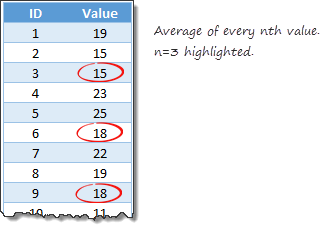Lets say you have a large list of numbers, and you want to calculate the average of every nth value. Not the average of all numbers, but just every nth number.
That is what we will learn in next few minutes.
Few assumptions
Before we jump in to any formulas, first lets assume that all your data is in a table, conveniently named as tbl. Lets say this table has below structure.

Also, the value of n is a named cell N.
Average of every nth value
Approach 1: Using helper columns
 If you have no allergies towards nuts, dairy or helper columns, then this approach is easiest.
If you have no allergies towards nuts, dairy or helper columns, then this approach is easiest.
We just add an extra column to our tbl , called as helper.
In the helper column, write this formula.
=MOD([@ID], N)=0
This will fill the helper column with TRUE & FALSE values, TRUE for all nth values, FALSE for everything else. See aside.
Once we have the helper column, calculating average of every nth value is easy as eating every slice of a cake.
We use AVERAGEIF to do this.
=AVERAGEIF(tbl[Value],tbl[Helper],TRUE)
Approach 2: Not using helper columns
Now things get interesting. Lets say you want to calculate average, but not use any helper columns.
First the formula:
=AVERAGE(IF(MOD(tbl[ID], N)=0,tbl[Value]))
Array entered.
Lets understand how it works:
We want the average of every nth item of tbl[Value] column.
In other words, we want average of every item of tbl[Value] column, whose corresponding tbl[ID] value is perfectly divisible by n.
How do we know when a value is perfectly divisible by another?
Don’t worry. You don’t have to do the long division on paper now. Instead we use Excel’s MOD function.
When a value is perfectly divisible by another, the reminder is zero.
So, MOD(value1, value2) = 0 means, value2 divides value1 perfectly.
That means…
We want the average of tbl[Value] when MOD(tbl[ID], N) = 0
Lets write that in Excel formula lingo.
=AVERAGE( IF(MOD(tbl[ID], N) = 0, tbl[Value]) )
This formula results in a bunch of values and FALSEs. Assuming N=3, this is what we get (for sample data):
=AVERAGE({FALSE;FALSE;15;FALSE;FALSE;18;FALSE;FALSE;18;FALSE;FALSE;15;FALSE;FALSE;14; …})
Since AVERAGE formula ignores any logical values, it will calculate the average of {15, 18, 18, 15, 14 … } and returns the answer you are expecting.
As this formula is processing arrays instead of single values, you need to array enter it (CTRL+SHIFT+Enter after typing the formula).
Bonus scenario: Average of FEBRUARY values only!
Here is a bonus scenario. Lets say you want to calculate the average sales of FEB alone… Then you can use AVERAGEIF (or AVERAGEIFS, if you want to have multiple conditions).
=AVERAGEIF(tbl[value], tbl[month], “FEB”)

Download example workbook:
Click here to download the example workbook. It contains all the techniques explained in this post. Play with the data & formulas to understand better.
Time for some challenges…
If you think averaging every nth value is not mean enough, try below challenges. Post your answers using comments.
- Write a formula to calculate average of every nth value, starting at row number ‘t’.
- Write a formula to calculate average of every nth value, assuming your table has only value column (no ID column).
Go ahead. Show off your formula skills. Post your answers in comments section.
Improving your Excel batting average
Calculating averages predates slice bread. Folklore says that when first neanderthal figured out how to express numbers and carved 2 of them on a cave wall, his manager walked by and asked “What is the average of these two? Eh?” and thumped her chest.
Although caves & wall carvings are replaced by cubicles & spreadsheets, we are still calculating averages, almost 2.9 million of them per hour.
So it pays to learn a few tricks about Excel Average formulas. Check out below to improve your average:
- Calculating Moving Average, Weighted Average
- Average of top 5 values
- Show averages & distribution in your charts
- Using SUMIFS formula (same tricks apply to AVERAGEIF, AVERAGEIFS too)
If your boss is the kind who thumps her chest and mocks you for your poor Excel skills, don’t cave in. Fight back. Enroll in Excel School and show that you can evolve.




















